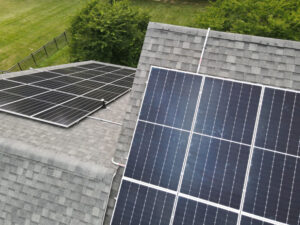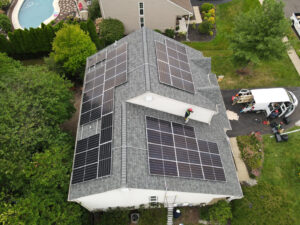Solar energy, which is critical in today’s pursuit of sustainable solutions, plays an important role in the modern energy landscape. At its core, it embodies the fundamentals of solar power, converting the sun’s abundant energy into usable electricity and demonstrating a renewable energy source. Beyond providing an overview of solar energy, its importance extends to being a cornerstone of green energy solutions, which are critical for the future of energy. Adopting solar power is critical for a sustainable future because it provides a viable, environmentally friendly alternative for meeting global energy demands while protecting our planet.
Basic Concepts of Solar Energy
Solar energy, harnessed through the ingenious use of photovoltaic cells in solar panels, fundamentally transforms sunlight into electrical power. These cells initiate an electrical current upon exposure to sunlight, encapsulating the essence of how solar power works. This conversion process not only marks a significant stride in renewable energy technology but also positions solar energy as a quintessential, inexhaustible resource. It offers a sustainable and clean alternative to traditional energy sources, like fossil fuels. By tapping into the limitless energy of the sun, solar power not only diminishes our carbon footprint but also aligns with global initiatives to combat climate change, underscoring its pivotal role in driving the shift towards a more sustainable, greener future.
The Technology Behind Solar Panels
Understanding Photovoltaic Cells
Photovoltaic cells are the heart of solar panel technology, functioning as the crucial components that convert sunlight into electricity. These cells, made of semiconductor materials (typically silicon), absorb photons from sunlight and generate an electric current through the photovoltaic effect. This process involves the creation of electrical charges in the cell that move in response to an internal electric field, resulting in energy conversion. The efficiency and effectiveness of this conversion are central to the overall performance of solar panels, illustrating the remarkable capability of photovoltaic technology to harness natural sunlight and transform it into a usable, renewable energy source.
Different Types of Solar Panels
- Monocrystalline Solar Panels
- High efficiency, made from single-crystal silicon, ideal for limited space.
- Polycrystalline Solar Panels
- Cost-effective, made from multiple silicon crystals, slightly lower efficiency.
- Thin-Film Solar Panels
- Flexible and lightweight, suitable for various surfaces, lower efficiency.
- Passivated Emitter and Rear Cell (PERC) Panels
- An enhanced version of traditional panels, improved efficiency and performance.
- Bifacial Solar Panels
- Capture sunlight from both sides, ideal for reflective environments.
- Concentrated PV Cell (CPV) Panels
- Concentrate sunlight onto high-efficiency cells, for specialized projects.
Factors Affecting Solar Panel Efficiency
Several factors influence the efficiency of solar panels, each playing a crucial role in how effectively they convert sunlight into electricity:
- Sunlight Exposure: Direct exposure to sunlight is key; more sunlight means more energy.
- Panel Angle and Placement: Proper angling and positioning maximize sunlight absorption, crucial for optimal performance.
- Temperature: High temperatures can lower efficiency, despite solar panels relying on sunlight.
- Panel Quality: The better the quality, the higher the efficiency and performance of the panels.
- Shading: Shadows from trees or buildings can significantly reduce a panel’s solar intake.
- Dirt and Debris: Clean panels are efficient panels; dirt and debris can block sunlight.
- Aging of Panels: Over time, panels may become less efficient due to wear and tear.
- Inverter Efficiency: The conversion of solar energy to electricity hinges on inverter efficiency.
- System Maintenance: Regular checks and maintenance keep panels at peak performance.
- Weather Conditions: Cloudy or overcast days can impact the amount of energy panels harnessed.
Advantages of Using Solar Energy
Environmental Benefits, Economic Savings, and Incentives
Solar energy offers substantial environmental and economic benefits, solidifying its status as a key player in sustainable energy solutions. Environmentally, it significantly reduces carbon footprints and greenhouse gas emissions, mitigating climate change impacts and fostering cleaner air, which is crucial for a healthier planet. Economically, adopting solar power leads to notable savings on electricity bills over time, effectively balancing out the initial costs of installation. Moreover, various financial incentives like tax credits, rebates, and grants further enhance its affordability, encouraging broader adoption. These dual advantages of solar energy not only emphasize its role in environmental preservation but also highlight its financial viability, making it an attractive, sustainable choice for both individuals and businesses.
Contribution to Energy Independence
Solar energy significantly contributes to energy independence by fostering energy autonomy and reducing reliance on traditional power grids and fossil fuels. By generating electricity locally through solar panels, individuals and communities can achieve a level of self-sustainability, lessening their dependence on external energy sources. This shift not only enhances energy security but also empowers consumers to have greater control over their energy usage and costs. The move towards solar energy represents a step towards a more resilient and self-reliant energy future, where renewable sources play a crucial role in meeting our energy needs.
The Process of Installing Solar Panels
Steps in Installation
- Site Assessment: Evaluating the suitability of the location for optimal sunlight exposure.
- Design and Planning: Customizing the solar system design to meet specific energy needs and roof layout.
- Permitting: Obtaining necessary permits and approvals from local authorities.
- Installation: Mounting solar panels and setting up the electrical systems.
- Inspection and Connection: Conducting inspections and connecting the system to the power grid.
Considerations Before Installation
- Energy Requirements: Assessing the energy needs to determine the size of the solar system.
- Financial Planning: Evaluating costs, budgeting, and exploring financing options.
- Roof Condition: Ensuring the roof structure is suitable and robust enough for solar panel installation.
- Local Regulations: Understanding local regulations and available incentives.
Maintenance and Durability
- Regular Cleaning: Keeping panels clean to maintain efficiency.
- Periodic Inspections: Conducting regular inspections to detect and rectify any issues.
- System Monitoring: Using monitoring systems to track performance and identify any anomalies.
- Long-Term Durability: Understanding that solar systems typically have a lifespan of 25-30 years with minimal maintenance requirements.
Challenges in Adopting Solar Energy
- Initial Investment Costs
- Significant upfront costs for purchasing and installing solar panels.
- Expenses vary based on system size and location.
- Long-term savings on energy bills and government incentives can offset initial costs.
- Viewed as a strategic investment with environmental and financial returns.
- Dependence on Weather and Climate
- Efficiency is influenced by weather conditions; sunny days increase output, and cloudy days may decrease it.
- Technological advancements have enhanced panel efficiency in various weather scenarios.
- Regional climate impacts solar energy production; sunnier areas yield more energy.
- Essential to consider optimal system performance and energy potential assessment.
- Space Requirements for Installation
- Space for installation determines the number of panels and energy output.
- Requires a balance between available space (usually rooftops) and sunlight exposure.
- The size and angle of the installation area, and potential obstructions like trees or buildings, are crucial.
- A proper understanding of space dynamics is vital for maximizing energy capture and efficient installation.
Conclusion
Solar energy stands out as a key to sustainable and renewable energy, combining advanced technology with environmental and economic benefits. This overview has delved into the workings of solar panels, their types, efficiency, and the significant role they play in reducing carbon footprints and promoting energy independence. In essence, solar power is not just an energy solution; it’s a step towards a greener future, highlighting its importance in the global shift towards more sustainable living. This exploration underscores the value of embracing solar energy for a cleaner, more sustainable world for future generations.
Ready to embrace a sustainable future with solar energy? Discover the potential of solar panels with Sunwise USA! Our expert team at Sunwise USA is dedicated to guiding you through the transition to renewable energy, offering tailored solutions that fit your unique needs. Whether you’re looking to reduce your carbon footprint, achieve energy independence, or simply save on electricity bills, Sunwise USA has the expertise and technology to make it happen. Don’t wait to make a positive impact on the environment and your wallet. Visit us at Sunwise USA today and take the first step towards a brighter, greener future with solar power!







